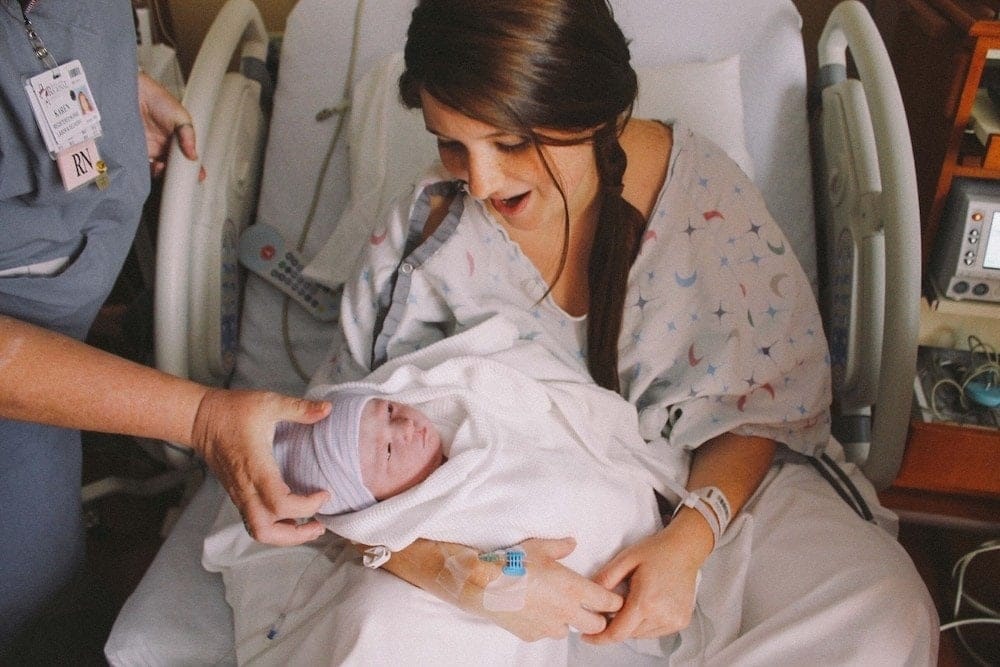They did what? 7 fascinating facts about birth through history

Wait, what?!
Table of Contents
When you stop and think about it the entire process of pregnancy and birth, and everything that comes with it, is pretty mind-boggling. I mean really—who grows in your what and comes out of where? Whoa.
But looking back at the history of birth is even more fascinating.
Take a look at these facts, and then let us all collectively thank the stars we were born when we were.
1. Pregnancy tests have been around for a long time
The first urine-based pregnancy test was recorded in Ancient Egypt in 1350 B.C.—more than 3000 years ago. A woman would urinate on barley and wheat seeds for a few days, and if they grew it meant she was pregnant. If barley grew, she was pregnant with a boy, and if wheat grew she was pregnant with a girl.
And get this—the Office of NIH History reports that in 1963 this was tested…and found to be true 70% of the time (just the pregnancy test part, not the gender reveal)!

In the 1550’s, people known as, wait for it… “piss prophets” claimed they could look at a woman’s urine and determine if she was pregnant.
The concept of hormones was discovered in the 1890s, and in the 1920s the pregnancy hormone HCG was detected. In 1927, scientists would inject a woman’s urine into an immature rat or mouse—if she was pregnant, the rodent would become in heat.
2. Gender selection
Until fairly recently, people believed that a baby’s gender was determined at birth (not at conception). So as you can imagine, many theories have existed regarding how to control the baby’s sex.
For example, women were encouraged to stay in bed for the weeks leading up to birth to improve their odds of having a boy.
In 1059, Dr. Trotula wrote, “If they wish to have a male child let the man take the womb and vulva of a hare and have it dried and pulverized. Blend it with wine and let him drink it. Let the woman do the same with the testicles of the hare and let her be with her husband at the end of her menstrual period, and she will conceive a male.”

Aristotle introduced the theory that girl babies were the result of abnormalities—boys were superior, so when a girl was born, it was because something had gone wrong. He also believed that one was more likely to have a boy if sex occurred when the winds were blowing north and not south and that men with “thicker” sperm were more likely to produce males.
In the 1700s, it was believed that a man’s right testicle and a woman’s right ovary were responsible for making boy babies—so people sometimes had their left testicle or ovary removed.
3. The first baby showers
Before giving birth, a royal woman would receive a blessing and be paraded through the streets as the public wished her well. She then spent about a month confined to her bedroom, a period known as lying-in. Her chambers were covered with tapestries and made dark and warm to replicate the environment of the uterus. Regular women did retreat from the public as well, though they usually had to find other work to do until the moment they gave birth.
BTW, she wasn’t allowed to return to society until six weeks after the baby—because she was too dirty, both physically and morally. She, therefore, missed her baby’s christening.

4. When royalty gave birth, it was a public event.
In The Raven Report, Jennifer Jeffers writes, “The birth of a monarch was not just any old day—it was a political event that could have deep implications for an entire nation… As such, it was not regarded as a private affair, but rather as a moment of significant public concern… As a future ruler, the offspring belonged more to the people than to the queen herself. And as a result, she gave birth in front of many spectators, all of whom watched the process carefully to confirm the sex and health of the baby… and to avoid any foul play.”

When Marie Antoinette gave birth in 1778, two-hundred people were in attendance—that is not a typo. 2-0-0. It is rumored that the overwhelm of that experience caused her to faint during her birth. I am almost fainting just writing about it so, yeah—I believe it.

5. Pain relief
The pain of childbirth was believed to be a result of Eve’s transgressions in the Garden of Eden. The Bible reads, “I will multiply your pains in childbirth. You shall give birth to your children in pain.”
An English will from 1508 indicates that women wore girdles stitched with silver and jasmine to help relieve the discomfort of pregnancy and the pain of childbirth. Women held religious items during birth, put amber and other stones on their bodies, and wrapped themselves in special cloths to diminish the pain.
When Queen Victoria gave birth to her 6th child, Prince Leopold, in 1853, she inhaled chloroform from a kerchief for pain relief. She later wrote of the experience stating, “that blessed Chloroform…soothing, quieting and delightful beyond measure,” and thus began the universal desire for pain medications during labor. Chloroform was also widely used during medical procedures such as amputations. Cocaine was also used for labor pain medication.
Until the mid-1800’s, women drank caudle, a mixture of alcohol and oatmeal (sometimes flavored with cayenne or nutmeg) while in labor. It’s reasoned that this was partially to do with pain management and postpartum recovery, and partially to do with preventing infection—more on that in a minute.
Women might also bake a cake while they were in labor called a groaning cake—the smell of the cake, along with the work of baking it, was thought to ease the discomfort of labor.

6. Midwives
The history of midwives will have to be its own article entirely. But here are a few little nuggets to leave you with:
Midwives have been around forever. They are, for example, in the Bible. A midwife attended Jesus’s birth, and in ancient Egypt, midwives were told by the Pharaoh, “When you serve as midwife to the Hebrew women, and see them upon the birthstool, if it is a son, you shall kill him. But if it is a daughter, she shall live.”
Midwives, in fact, attended all births—doctors were almost never present. Birth was considered just for women, and men did not start attending births until the 1800s. Even then, they were instructed not to look at the women they were caring for.
When a midwife attended the birth of a royal or well-to-do person, she had to take an oath that she would not steal the placenta or umbilical cord, and use it for witchcraft.

7. Death—and a major improvement
The sad truth is that many, many women died during childbirth—as many as 1 in 34. Women often made wills before going to labor, because the chance of mortality was so high.
Midwives often performed baptisms because the rate of infant mortality was so high, they wanted to ensure the babies were baptized immediately. Cesarean sections were performed, but only after a mother had died with the hope of saving the baby.
In the 18th and 19th century, women were dying of Puerparel Fever, or childbed fever, in large numbers—women who got the infection had an estimated fatality rate of up to 80%. The reason behind this is, well, upsetting—so maybe don’t read this next part while you’re eating lunch.
Ready?

During this period, while many women were still giving birth at home, some women started giving birth in hospitals. Their births were attended by doctors, who didn’t start to specialize in various fields of medicine until the 1850’s. This meant they did everything—including surgeries, autopsies on cadavers, and delivering babies. Without washing their hands in between.
In 1846 Dr. Ignaz Semmelweism made this discovery and announced it from the rooftops—but no one listened (and eventually, he was fired). It wasn’t until 1875 when instrument sterilization and routine hand washing was common-place in hospitals.
So, to our great many ancestors who paved the way for us to have markedly improved birth conditions, thank you. Now please excuse me. Writing this really makes me need a glass of caudle.


































